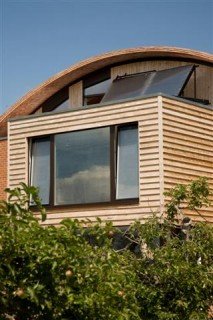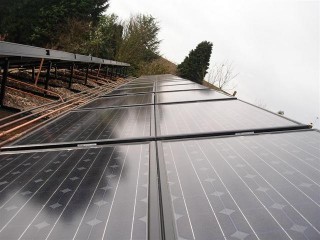![]() At VT, we know that when America gets off its bad energy addiction and jobs on with new technologies, we propel ourselves forward.
At VT, we know that when America gets off its bad energy addiction and jobs on with new technologies, we propel ourselves forward.
With this in mind, when we discover new energy-related ideas, technologies, and actions, we will bring them to your attention.
As it stands, Solimpeks Corp., a solar company based in Karatay, Turkey, has released the Volther hybrid solar collector, which produces electricity and hot water simultaneously.
The hybrid modules produced by Solimpeks Corp. allow extra module heat to be absorbed to produce hot water, thus optimizing efficiency, the company says:

Historically, the main drawback of many conventional photovoltaic systems has been the high initial cost as well as the limited amount of electrical output when compared to solar input.
This Volther hybrid solar collector system allows excess heat to be recaptured and boosts the system’s return on investment, according to Solimpeks Corp. Nowadays, most people and countries like to be self-supporting for their own energy needs.
They are looking most of all to durable energy sources like the sun, water, and wind or geothermal. The systems, which are most common on the market now supply only electricity or only heat.
Let us look to the Sun. The sun is an infinite source of energy and generates 10.000 more energy than what the world consumes. There are two systems commonly to harness this energy.
First, we have the solar collector that makes normally hot water out of the energy from the sun. Second, there are PV (Photovoltaic) modules, which convert sunlight into electricity. Both systems are increasing in popularity every day.
 Both systems utilize a black or dark surface that looks at the sun. This black surface absorbs the solar energy and heats up the solar collectors. However, when PV modules heat up their ability to generate electricity diminished at the rate of about 0.5 % for every Kelvin. So a 10-degree rise in temperature in a PV module means a loss of about 5% of electricity output.
Both systems utilize a black or dark surface that looks at the sun. This black surface absorbs the solar energy and heats up the solar collectors. However, when PV modules heat up their ability to generate electricity diminished at the rate of about 0.5 % for every Kelvin. So a 10-degree rise in temperature in a PV module means a loss of about 5% of electricity output.
To solve this problem scientists have been working on different methods. The most promising one is “cooling PV cells with fluid”. In the PV-T, which is a hybrid Photovoltaic and Thermal collector, the production of both electricity and hot water is achieved simultaneously.
The PV module’s heat is absorbed to produce hot water so that PV efficiency can be optimized as the heat is transferred into the fluid to produce hot water.
PV-T hybrid collectors have the following advantages:
- They have increased the electricity production performance of PV module
- Hybrid PV-T systems cover areas where electricity and heat energy are produced from the total, half of this field with PV modules, the remaining half of the thermal
- Thermal collectors and PV modules being installed side by side can create trouble in terms of availability and use and cause visual pollution. With PV-T modules, the electricity and hot water in the same area produce space-saving and reduce environmental pollution.
- Hybrid PV-T system’s ROI (return on investment) is shorter than PV systems.
Consequently, PV-T systems can reduce the temperature of PV cells resulting in an increased lifetime and efficiency. Calculations done by several scientists, organizations and universities indicate only 25 square meters of PV-T collectors are required for a normal family house in northern Europe to generate all their energy for an entire year.
When all U.S. Veterans get on the new energy train, we can take ourselves to a new better place. So get on and let’s fix this thing.
For additional information visit Solimpeks Solar Energy Corp at www.solimpeks.com










